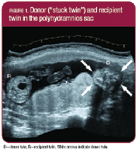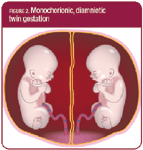Improving survival in twin-twin transfusion syndrome
Although serial amnioreduction is still widely used to treat this dangerous condition, a recent randomized trial found that when compared to amnioreduction at 15 to 26 weeks, overall perinatal survival is higher with laser ablation, which tries to reverse the disease process.
Twin-twin transfusion syndrome (TTTS), sometimes called "stuck twin syndrome," is an often fatal complication of monochorionic (MC) twin pregnancies. Untreated, the vast majority of fetuses with severe TTTS before 26 weeks' gestation will die.1 TTTS appears to result from a net unbalanced flow of blood between two fetuses in a monochorionic placenta that leads to one fetus (the "recipient") becoming hypervolemic with polyhydramnios at the expense of its sibling (the "donor"), which develops hypovolemia and eventual oligohydramnios.
Twinning in the United States continues to increase (with an incidence of 31.5 per 1,000 live births).2 Two things are behind this rising trend: greater use of assisted reproductive technologies (ART) and delayed conception in older women. Both have led to an increased frequency of dizygotic (fraternal) twins. In addition, ART techniques such as assisted zygote hatching can increase monozygotic twinning by up to eightfold.3


Five stages of TTTS have been proposed based on U/S findings8 :
Stage I: Oligohydramnios (maximum vertical pocket (MVP) <2 cm) and polyhydramnios (MVP >8 cm before 20 weeks' gestation; >10 cm after 20 weeks' gestation) but a bladder is still visible in the donor twin.
Stage II: Discordant amniotic fluid volumes with the bladder not seen in the donor twin on U/S.
Stage III: Doppler blood flow studies showing absent/reverse end-diastolic velocity in the umbilical artery, reversed flow in the ductus venosus, or pulsatile flow in the umbilical vein in either fetus.
Stage IV: One or both fetuses show signs of hydrops.
Stage V: One or both fetuses have died.
